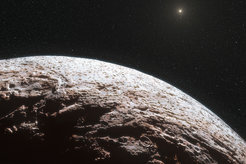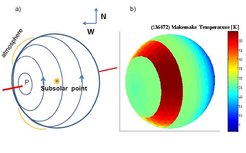No global atmosphere on Makemake

Makemake belongs to the class of trans-Neptunian objects (TNOs), which comprise over one thousand objects that have so far been discovered orbiting beyond Neptune. It is about two thirds of the size of Pluto, and travels around the Sun in a distant path that lies beyond that of Pluto. The dynamical and physical properties of primitive TNOs provide unique and important constraints on formation and evolution models of the Solar System.
The new, detailed observations with ground-based telescopes were now possible because the dwarf planet passed in front of a star — an event known as a stellar occultation. These rare opportunities are allowing astronomers for the first time to find out a great deal about the sometimes tenuous and delicate atmospheres around these distant members of the Solar System, and providing very accurate information about their physical properties.
The astronomers expected to find an atmosphere similar to Pluto, however, the disappearance of the distant star was very abrupt rather than the gradual fading one would expect if the dwarf planet had a significant atmosphere. The occultation observations also allowed the scientists to determine its size more accurately and to estimate Makemake’s density for the first time. Makemake has a slightly elliptical shape and is smaller than Pluto with minor and major axes of about 1430km and 1502 km.

Sketch of where a local atmosphere could roughly reside in Makemake’s limb. The arrows indicate the assumed direction of rotation and P indicates the pole region. The image on the right shows a thermal map of Makemake based on a thermophysical model and compatible with all available thermal observations. The local atmosphere would form due to solar heating at the subsolar region and stay in the same position while the dwarf planet rotates below it.
The dwarf planet was also part of a special observation campaign with the Herschel space telescope, to find out more about TNOs in general. The Herschel observations revealed some very peculiar properties for Makemake. In particular, the reflectivity of its surface was much larger than expected, indicating a fresh surface similar to new snow or white frost. At the same time, some very dark and therefore much hotter terrains are needed to explain Makemake's thermal emission. The Sun's radiation heats these darker terrains sufficiently so that there is still the possibility of a local atmosphere just above the hottest subsolar region. Temperatures of 50 K and above are possible, sufficient for nitrogen or - more likely in case of Makemake - methane sublimation and condensation at the hot and colder parts, respectively.

